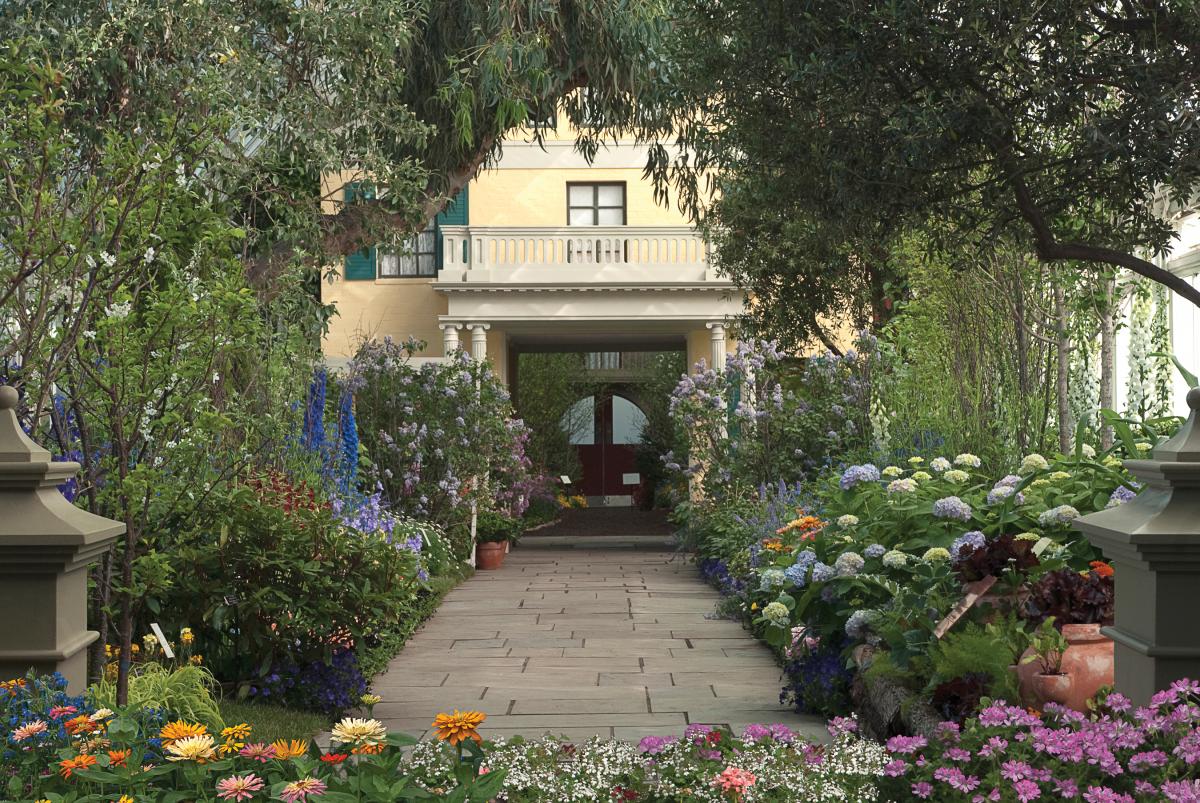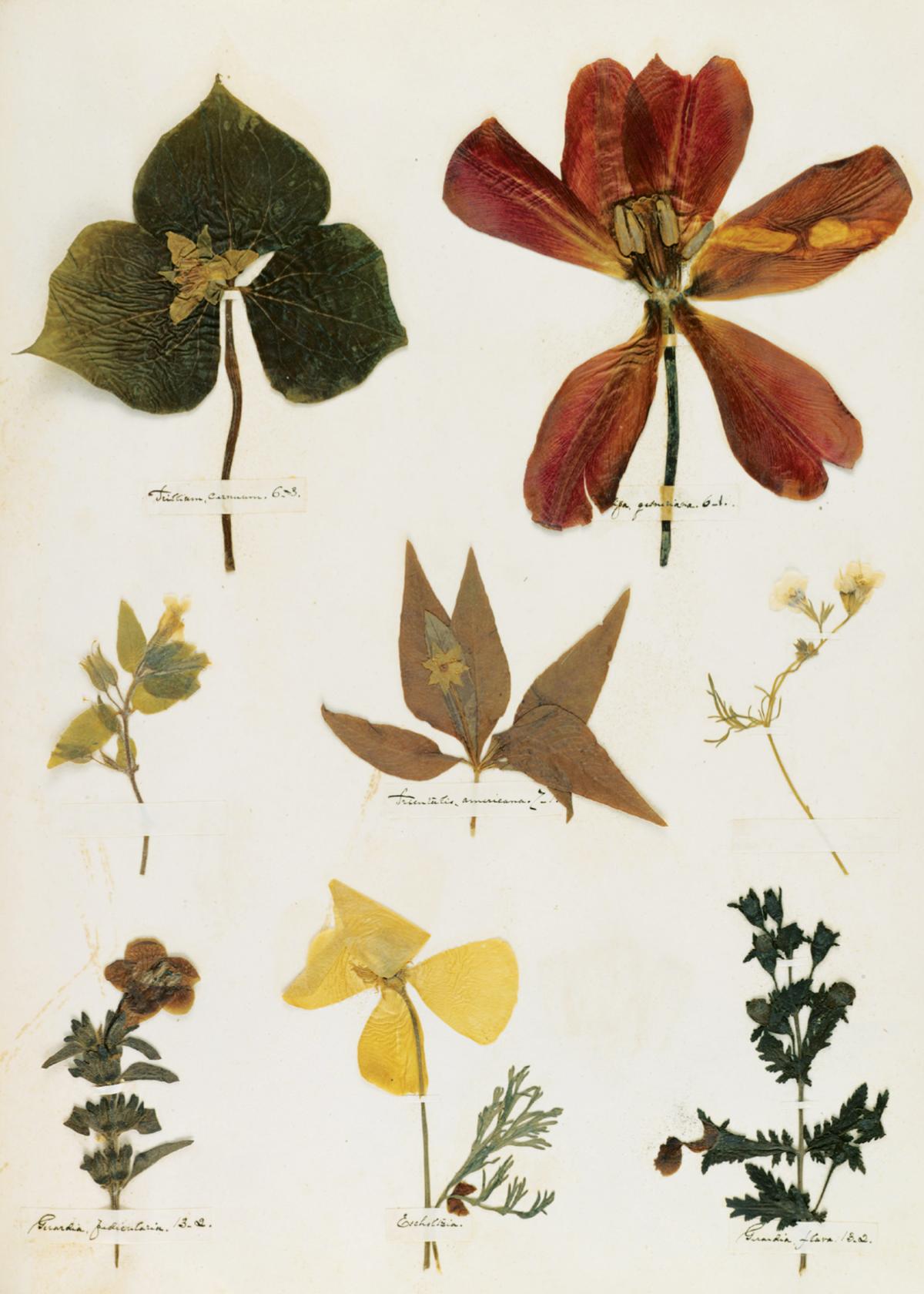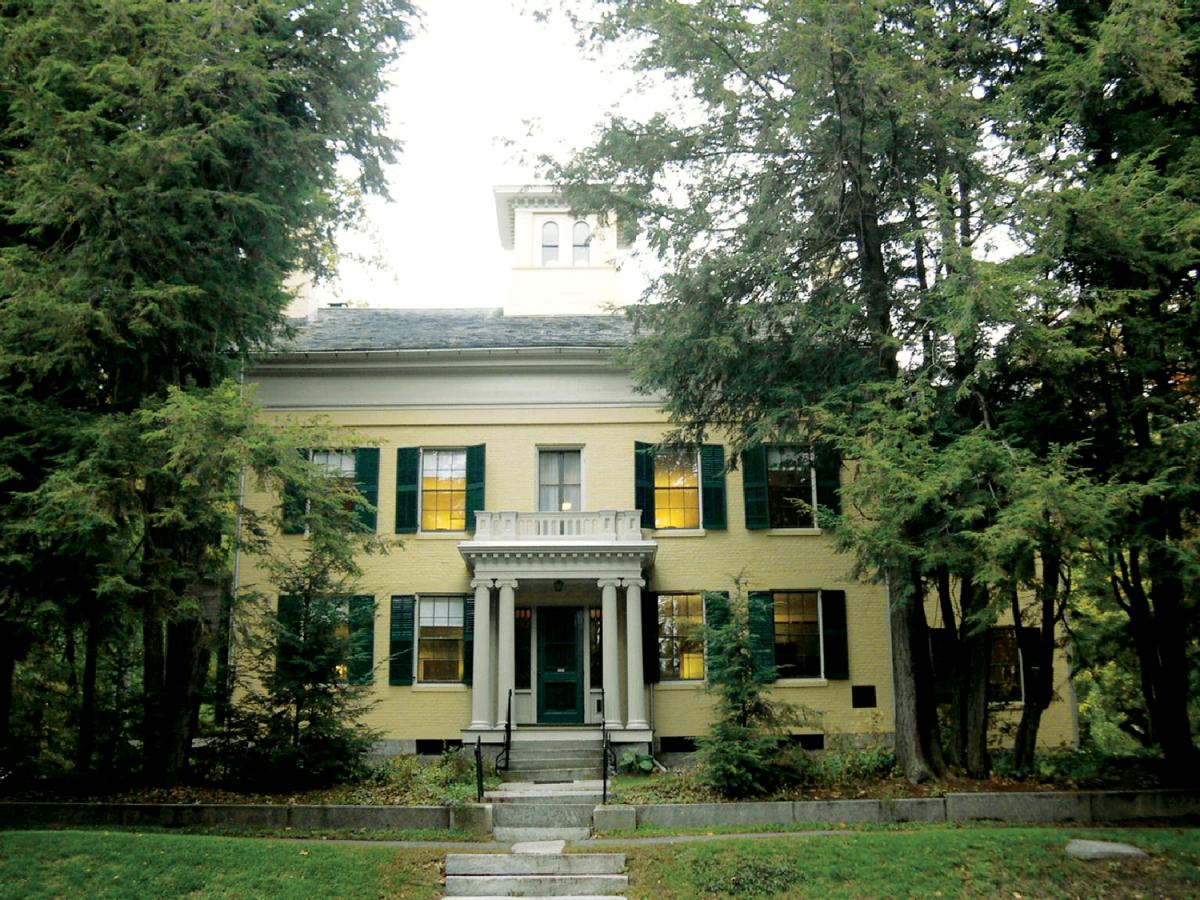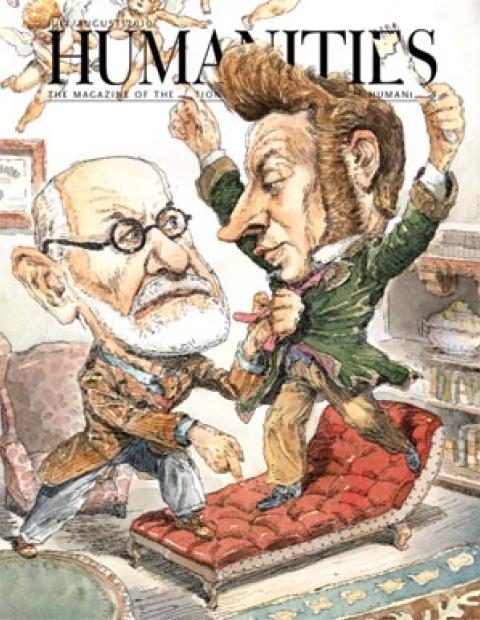“During her lifetime,” Susan Fraser insists, “Emily Dickinson was actually better known as a gardener than as a poet.”
Even the most cursory research reveals that Fraser, the director of the New York Botanical Garden’s Mertz Library, is correct. Fewer than a dozen of Emily Dickinson’s poems were published before her death in 1886, and these few had been so heavily edited that readers could not have imagined that here was a poetical pioneer who would rival Walt Whitman as the creator of a distinctively American voice. Yet everyone in Amherst, Massachusetts, knew of the extraordinary display of flowers, fruits, and vegetables she cultivated around the family’s Homestead. Even after she withdrew from society in her thirties, she continued to communicate with frequent gifts of bouquets to family and friends and neighbors. When her sister discovered Dickinson’s secret trove of eighteen hundred meticulously crafted poems after her death, what emerged was that Dickinson had planted as prolifically in her verse as in the landscape: Over a third of her poems rely on images drawn from her garden and the surrounding meadows and woods where she walked with her dog Carlo, hunting for wildflowers.
You could argue that a true understanding of Dickinson’s verse depends on a familiarity with her horticulture—and, indeed, that was the premise of the imaginative multimedia exhibition, “Emily Dickinson’s Garden: The Poetry of Flowers,” that was on display at the New York Botanical Garden this spring. The exhibition, which included a large conservatory showing, drew on the work of leading Dickinson scholars and new interpretations of the poet’s personal life.
This isn’t the first time that the public perception of Dickinson has undergone a profound metamorphosis. Yankee born and bred, the poet was shy and often, it seems, deliberately enigmatic, limiting and controlling her contact with the world beyond the fence and hemlock hedge that enclosed the Dickinson home. Though sociable through her youth, Dickinson became increasingly reclusive as an adult, eventually to the point that she refused to leave the Homestead’s house and grounds and spoke to those outside her immediate family only from behind doors. The few glimpses that townsfolk had of her in later decades was as a nocturnal, white-clad figure cultivating her garden by lantern light. Presumably, Dickinson chose nighttime for outdoor activities to avoid encounters with nosy passersby. Even her poems Dickinson fashioned into puzzles, compressing and juxtaposing images and metaphors so that they commonly allude rather than declare, yielding their layered messages only with extended study.
An essential key to unriddling Dickinson’s poetry, according to Judith Farr, is familiarity with its unique context. A leading Dickinson scholar and the author with horticulturist Louise Carter of The Gardens of Emily Dickinson, the first in-depth study of this aspect of the poet’s life, Farr served as a consultant to the botanical garden in planning the exhibition.
Born in 1830, Dickinson was well-educated for her day. In an era when women rarely were allowed to attain much more than basic literacy, she had completed the contemporary equivalent of a secondary education at nearby Amherst Academy and a subsequent year of study at Mount Holyoke Female Seminary, the forerunner of Mount Holyoke College. After this, Dickinson returned to the family home and traveled little during the rest of her life. What she experienced in her garden, then, played an enhanced role not only in her personal life but also in her poetical diction, imagery, and imagination.
This became clear with a trip to the Bronx to explore the New York Botanical Garden’s exhibition. In the public gallery attached to the Mertz Library, where a portion of the Dickinson show continues through August 1, there are several works that played a major role in Dickinson’s education and daily life. There’s a copy of the botany textbook Dickinson used as a student at Amherst Academy, and her herbarium. This leather-bound album contains some four hundred pressed plant specimens she collected from the woods and fields around the family home—each carefully labeled with the correct Latin name. There’s also a copy of Wild Flowers Drawn and Colored From Nature, a book Dickinson’s father gave her in 1859. One wonders what the budding poet, by then in her late twenties, made of the stanzas of saccharine, conventional verse in the folio-sized volume of colorful floral portraits.
No wonder then that Dickinson’s poetry is rich with botanical terminology such as “corolla,” “calyx,” “capsule,” and “stamen.” Farr recalls an occasion when a British scholar, in a public lecture, interpreted Dickinson’s reference to “The regiment of wood and hill / . . . The children of whose turbaned seas, / Or what Circassian land?” as a reference to Russian soldiers. He did not know, as Emily clearly did, that tulips, whose name is derived from the Turkish word for turban, are natives of the Caucasus, a region that includes Circassia. Another facet of Dickinson’s poetry typically overlooked by those unfamiliar with nineteenth-century horticulture is her use of the so-called “language of flowers.” To the educated Victorian, who would have understood her poetry had they known of it, every blossom symbolized some emotion or personal quality. For example, the violet, when tucked into a bouquet or poem signified humility, while a gift of daffodils, actual or verbal, represented regard for the recipient or even unrequited love. A rose, depending on its type and color, might stand for many things, but most commonly for love and beauty. When Dickinson wrote of an unknown, little rose, “Did I not take it from the ways / And lift it up to thee!”, she alluded to more than the sharing of a flower.
An understanding of Dickinson’s gardening, though, offers more than clues for textual analysis. “I was reared in the garden, you know,” the poet wrote at age twenty-nine in a letter to her cousin Louisa Norcross. It was true: Emily had grown up helping her mother with the family’s extensive plantings of food and floral crops. The family grounds included a locally renowned rose garden and fig trees from which Emily’s mother annually harvested fruit, despite the fact that their fourteen acres lay hundreds of miles to the north of that species’ natural range. After Emily returned from Holyoke, the flower garden largely passed into her care; the food crops became the responsibility of her younger sister Lavinia. Emily planted the luxuriant flower beds in tousled, cottage-garden style—one suspects that the description continued to apply after Emily’s death, when Lavinia had taken over the management of the flowers as well. Emily’s niece and editor, Martha Dickinson Bianchi, recalled:
All [Lavinia’s] flowers did as they liked: tyrannized over her, hopped out of their own beds and into each other’s beds, were never reproved or removed as long as they bloomed; for a live flower to Aunt Lavinia was more than any dead horticultural principle.
For someone who led a life as geographically circumscribed as Dickinson’s, her garden was to a substantial degree her world, and how she arranged that acreage reflected not only her taste but her worldview and daily experience. It is for this reason that the New York Botanical Garden’s vice president for horticulture, Todd Forrest, and his staff turned the interior of the conservatory into a botanical time machine, and re-created the flavor of Emily Dickinson’s landscape so that visitors could see the world as she did. This was not a snapshot in time. To create a fuller impression of Dickinson’s horticultural passions, the exhibit intermingled flowers such as daffodils and foxgloves that in a natural setting do not bloom simultaneously. Such a riot of bloom surely never existed at the Homestead, except in Emily’s poetry, but the exhibit did emphasize how botanically rich her home garden was.
Strolling down a garden path planted with trees and flowers of the types Emily grew, I passed through a facade copied from that of the Homestead and sat myself at a simple desk, a smaller version of the one Dickinson used. A window framed a view of a curving path that led to another, grander facade, this one drawn from the Evergreens. It was the house that Emily’s father built as a wedding present for her brother Austin and his bride, Susan, who was for most of her married life Emily’s closest friend (or even, if some scholars are to be believed, her lover). On the re-created desk there was a notebook with a pencil and an invitation for visitors to record their thoughts. A brief scan revealed this to be filled with praise for the flowers “so pretty and beuteful” (Emily herself was an eccentric speller) from Sara—“you don’t know me”—and, on another page, an outpouring of verse:
In Moscow we had not the flowers
In Kiev we had but snow,
but ask if you are brighter then [sic]
former?
or fairer then latter, the answer still,
is no
—Boris loves Julia
Outside the conservatory, the NYBG’s Education Department had paired poem-bearing placards with plants or views relevant to the text. The hope was that by creating a sense of immediacy these juxtapositions might inspire in readers new understandings. This was not at all unlikely, according to another of the exhibition’s consultants, Marta McDowell.
McDowell was an amateur gardener with a special interest in the history of the female figures in that field but little interest in poetry, when a corporate business trip took her to central Massachusetts. To fill some spare hours, she toured the Homestead, now a museum maintained by Amherst College. McDowell was so intrigued by the garden that she not only read Dickinson’s poetry, she began searching out every mention of a plant in the poet’s letters and papers, eventually helping the museum personnel assemble a detailed list of what the garden included in its heyday. A consultant now on the preservation of historic landscapes, McDowell wrote a hybrid gardening guide and biography, Emily Dickinson’s Gardens, which offers down-to-earth advice that Dickinson the gardener would surely have appreciated.
Erect a screen between yourself and the world, and you tempt outsiders to project onto it a reflection of themselves. This certainly is what has happened to Dickinson. Her Victorian contemporaries tended to view her as a virginal hermit—“the nun of Amherst.” After her family and friends published the first collection of her poems in 1890, four years after her death, Dickinson was widely hailed as a tragic genius, the victim of unrequited love. Heavy-handed editing in the first editions of her poems continued to conceal the full originality of her work, however, and it wasn’t until a restored text was published in 1955 that she finally took her rightful place in the poetic canon. She became an icon for feminists in the seventies and eighties, and, more recently, her letters have been mined for evidence of full-blooded passions as Dickinson has become the heroine of a lusty historical novel (complete with tattooed handyman), as well as more scholarly studies of her love affairs (consummated or not, depending on whom you believe).
The reinvention of Dickinson by each generation of readers, says McDowell, is the mark of a great poet, whose work holds up a mirror in which people through the ages can see some version of themselves. What Emily Dickinson herself would make of all the personas imposed on her by the public imagination is hard to say, asserts Farr. The scholarly battles would likely have piqued the poet’s impish sense of humor. (Farr has seen academic antagonists wrestling over points of Dickinson’s work in the most literal, physical sense. One pushed and pinned another up against a wall while they screamed at each other.) The ongoing, very personal speculations concerning her love life would more probably have struck Dickinson as invasive and offended her sense of decorum. Perhaps Dickinson would have simply shrugged, put down her pen, and pulled on her gardening gloves.
One imagines her dismissively muttering, “Oh fraud that cannot cheat the Bee— / Almost thy plausibility / Induces my belief” as she slipped out the door, on her way, once again, back to the flowers.










